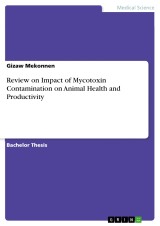Details

Review on Impact of Mycotoxin Contamination on Animal Health and Productivity
1. Auflage
|
CHF 15.00 |
|
| Verlag: | Grin Verlag |
| Format: | |
| Veröffentl.: | 27.01.2020 |
| ISBN/EAN: | 9783346103574 |
| Sprache: | englisch |
| Anzahl Seiten: | 29 |
Dieses eBook erhalten Sie ohne Kopierschutz.
Beschreibungen
Bachelor Thesis from the year 2019 in the subject Veterinary medicine, grade: 18, , course: Seminar on Animal Health, language: English, abstract: Mycotoxins are secondary metabolism of filamentous fungi, which under suitable temperature and humidity conditions, and found in various foods and feeds, causing negative effect for human and animal health.There are different mycotoxins which have agricultural and economic importance including aflatoxins, ochratoxins, trichothecenes, zearalenone, fumonisins, tremorgenic toxins, and ergot alkaloids. Mycotoxins occur more frequently in areas with a hot and humid climate, favourable for the growth of molds, they can also be found in temperate zones.In comparison to monogastric species, ruminant animals are generally less susceptible to the adverse effects caused by contamination of feeds with mycotoxins because presence of rumen microflora in rumen. However, a number of mycotoxins resist rumen degradation, causing distinct clinical signs of intoxication. Dairy cattle can be exposed to different number of mycotoxins because complex feeding diet originating from different feed materials such as roughage and concentrates. Exposure of diary catte to these mycotoxins may result in unexpected health problem. Due to apre-existing negative energy balance, cows in the transition period are considered to be particularly sensitive to the exposure to feeds. The variation of mycotoxinoccurence due to different factors, including agricultural practices and climatic conditions. Aflatoxins (AFs) are found in maize and peanuts, aswell as in tree nuts and dried fruits. OTA is found mainly in cereals, but significant levels of contamination may also occur in wine, coffee, spices and dried fruits. Other products of concern are beans, roasted coffee and cocoa, malt and beer, bread and bakery products, wines and grape juices, spices, poultry meat and kidneys, pig kidneys and pork sausages. The production of secondary metabolism is the effect of Fungal metabolism Secondary metabolites, are formed from a relatively small number of branch points of primary metabolic pathways. Among them some of these secondary metabolites are used as antibiotics, while others are very toxic and carcinogenic to humans and animals.Economic impact associated with mycotoxicosisincluding:Slower growth rates, Poor conception rates, inconsistentmanure, Increased disease susceptibility, Reduced production performance, loss of animal and human life, veterinary and public cost of treatment.
Diese Produkte könnten Sie auch interessieren:

Nursery Rearing of Nonhuman Primates in the 21st Century

von: Gene P. Sackett, Gerald Ruppenthal, Kate Elias

CHF 236.00















